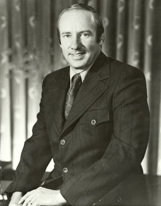Tom Railsback facts for kids
Quick facts for kids
Tom Railsback
|
|
|---|---|
 |
|
| Member of the U.S. House of Representatives from Illinois's 19th district |
|
| In office January 3, 1967 – January 3, 1983 |
|
| Preceded by | Gale Schisler |
| Succeeded by | Lane Evans |
| Member of the Illinois House of Representatives | |
| In office 1962–1966 |
|
| Personal details | |
| Born |
Thomas Fisher Railsback
January 22, 1932 Moline, Illinois, U.S. |
| Died | January 20, 2020 (aged 87) Mesa, Arizona, U.S. |
| Resting place | Rock Island Memorial Park Cemetery Rock Island, Illinois |
| Nationality | American |
| Political party | Republican |
Thomas Fisher Railsback (born January 22, 1932 – died January 20, 2020) was an American politician and lawyer. He served for 16 years in the United States House of Representatives, from 1967 to 1983. He was a member of the Republican Party. A key moment in his career was his role on the House Judiciary Committee in 1974. This committee voted to recommend the removal of President Richard Nixon from office.
Contents
Early Life and Education
Thomas Railsback was born on January 22, 1932. His hometown was Moline, Illinois. His father, Fred Railsback, was a lawyer for the city.
Tom went to public schools in Moline. He earned a bachelor's degree from Grinnell College in 1954. Later, he studied law at Northwestern University School of Law in Chicago. He received his law degree in 1957. After finishing school, he served in the United States Army from 1957 to 1959.
Political Career
Railsback began his political journey in Illinois. In November 1962, he was elected to the Illinois House of Representatives. He served there as a Republican.
Four years later, in 1966, he ran for the United States House of Representatives. He won the election, beating the current Democratic representative, Gale Schisler. This marked the start of his long career in the U.S. Congress.
Role in Nixon Impeachment
While in Congress, Railsback was known as a moderate Republican. He was a long-time member of the United States House Committee on the Judiciary. This committee played a big part in the process to remove President Richard Nixon from office. This happened between 1973 and 1974.
Railsback worked with a Democratic colleague, Walter Flowers. Together, they led a group of Republicans and Democrats. This group created two main reasons for removing Nixon from office. These reasons were:
- Trying to stop the investigation into the Watergate scandal.
- Misusing his power as president many times.
Railsback and five other Republicans on the committee voted with all the Democrats. This vote sent the reasons for removal to the full House of Representatives. On July 24, 1974, Railsback gave an emotional speech. He said his duty to the Constitution was more important than his friendship with Nixon.
Many Republicans in Congress supported Nixon's removal. This was a major reason why Nixon decided to resign from office the next month. Even though some people were angry with Railsback, he was re-elected four more times.
Key Laws and Issues
During his time in the House, Railsback helped pass important laws. He played a key role in the Juvenile Justice and Delinquency Prevention Act of 1974. This law aimed to help young people and prevent crime.
In 1979, he worked with Wisconsin Democrat David Obey. They proposed a law to reduce the influence of special interest groups in elections. Railsback also disagreed with President Ronald Reagan on some issues. For example, he opposed cutting funds for the Legal Services Corporation. This group provides legal help to people who cannot afford it.
End of Congressional Career
Railsback had strong support in his district. His district included both rural Republican areas and labor strongholds. He built a secure political base by supporting civil rights and some labor positions.
However, in 1982, Illinois lost two congressional districts. This happened after the 1980 census. Railsback's district was redrawn and became much more conservative. He lost the Republican primary election to State Senator Kenneth G. McMillan. McMillan was a more conservative Republican. McMillan then lost the general election to Democrat Lane Evans.
Railsback was a mentor to Raymond H. LaHood. LaHood worked for Railsback from 1977 to 1982. Later, LaHood became a U.S. Representative himself. He also served as the United States Secretary of Transportation under President Obama.
Later Life
After leaving Congress, Railsback became a lobbyist. A lobbyist tries to influence lawmakers on behalf of a group. He served as an executive vice president for the Motion Picture Association of America. He also worked for the Federal Judges Association.
Railsback later retired to Idaho. He lived in McCall and Meridian with his wife, Joye.
He passed away on January 20, 2020, in Mesa, Arizona. He had been in declining health.
Personal Life
Thomas Railsback married Patricia Sloan in 1955. They had four daughters together. He later married Joyelyn (Silver) Railsback, known as Joye. He had 19 grandchildren.

